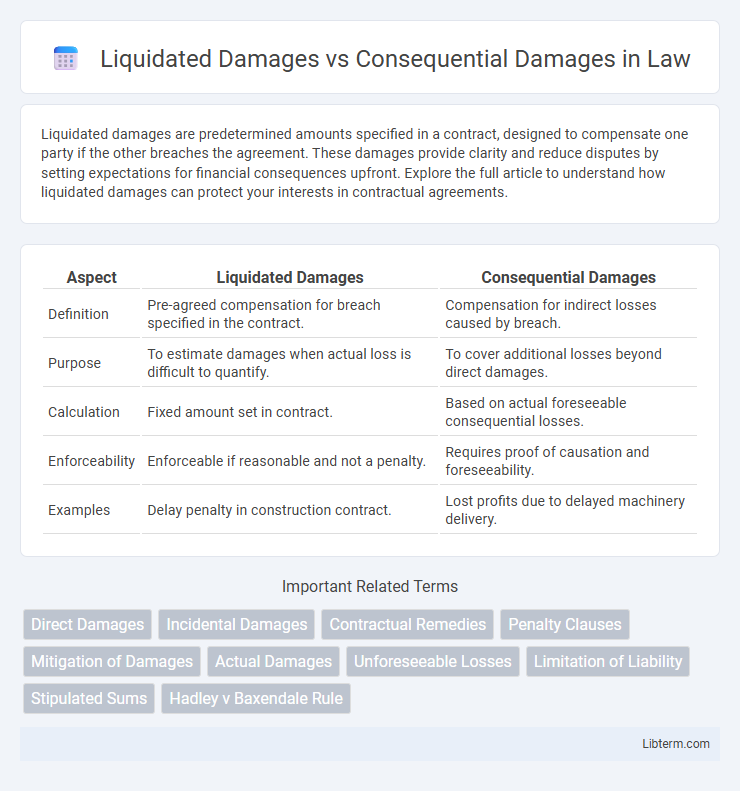Liquidated damages are predetermined amounts specified in a contract, designed to compensate one party if the other breaches the agreement. These damages provide clarity and reduce disputes by setting expectations for financial consequences upfront. Explore the full article to understand how liquidated damages can protect your interests in contractual agreements.
Table of Comparison
| Aspect | Liquidated Damages | Consequential Damages |
|---|---|---|
| Definition | Pre-agreed compensation for breach specified in the contract. | Compensation for indirect losses caused by breach. |
| Purpose | To estimate damages when actual loss is difficult to quantify. | To cover additional losses beyond direct damages. |
| Calculation | Fixed amount set in contract. | Based on actual foreseeable consequential losses. |
| Enforceability | Enforceable if reasonable and not a penalty. | Requires proof of causation and foreseeability. |
| Examples | Delay penalty in construction contract. | Lost profits due to delayed machinery delivery. |
Introduction to Contract Damages
Contract damages encompass various forms, primarily including liquidated damages and consequential damages, each serving distinct purposes in breach scenarios. Liquidated damages represent pre-agreed, fixed sums specified within contracts to provide certainty and avoid litigation over actual loss calculation. Consequential damages, or special damages, cover indirect losses resulting from a breach, such as lost profits, that must be proven to directly stem from the contractual violation.
Definition of Liquidated Damages
Liquidated damages are a predetermined sum agreed upon in a contract, intended to compensate a party for specific breaches without requiring proof of actual loss. This amount is established during contract formation to provide certainty and avoid protracted disputes over damages. Unlike consequential damages, which cover indirect or secondary losses caused by a breach, liquidated damages represent direct, reasonable estimates of anticipated harm from the breach itself.
Understanding Consequential Damages
Consequential damages refer to losses that do not directly result from a breach of contract but occur as a foreseeable consequence of the breach, such as lost profits or additional operational costs. These damages require proof of actual harm and foreseeability at the time of contract formation, distinguishing them from liquidated damages, which are predetermined and agreed upon in the contract. Understanding consequential damages involves recognizing their role in compensating indirect losses that go beyond the immediate impact of a contractual failure.
Key Differences Between Liquidated and Consequential Damages
Liquidated damages are predetermined sums agreed upon in a contract, payable if a specific breach occurs, ensuring certainty and avoiding protracted disputes. Consequential damages, also known as special damages, cover indirect losses resulting from the breach, such as lost profits or additional costs, which must be proven and are often harder to quantify. The key difference lies in liquidated damages being fixed and agreed in advance, while consequential damages are variable and depend on the actual impact of the breach.
Legal Enforceability of Liquidated Damages
Liquidated damages are pre-determined sums agreed upon by parties in a contract to compensate for specific breaches, enhancing predictability and enforceability in legal disputes. Courts typically uphold liquidated damages clauses if the amount is a reasonable estimate of actual harm and not punitive, differentiating them from consequential damages, which cover indirect losses and require proof of causation. Ensuring that liquidated damages represent a genuine pre-estimate of loss is critical for their enforceability under contract law jurisdictions.
Common Examples of Consequential Damages
Consequential damages often include lost profits, loss of business reputation, and additional operational costs resulting from a breach of contract. Unlike liquidated damages, which are predetermined and specified in the contract, consequential damages are indirect losses that arise naturally from the breach. Common examples include lost sales due to delayed delivery, damage to customer relationships, and expenses incurred from business interruption.
Drafting Contract Clauses: Best Practices
When drafting contract clauses for liquidated damages and consequential damages, clearly define the scope and limits of each to avoid ambiguity and litigation. Use precise language to specify the agreed-upon amount or formula for liquidated damages, ensuring it reflects a reasonable estimate of actual harm without constituting a penalty. Explicitly exclude or limit consequential damages through tailored waiver provisions to protect parties from unforeseeable indirect losses and align with governing law requirements.
Limiting Liability Through Damages Clauses
Liquidated damages clauses specify predetermined amounts parties agree to pay if a breach occurs, providing certainty and limiting liability by avoiding protracted damage assessments. Consequential damages, often excluded in contracts, cover indirect losses like lost profits, which can be extensive and unpredictable, making their limitation critical to risk management. Clearly defined damages clauses help businesses control exposure by capping recoverable damages and reducing the likelihood of costly litigation over ambiguous loss categories.
Jurisdictional Variations in Damages Awards
Jurisdictional variations significantly impact the enforceability and calculation of liquidated damages versus consequential damages in contract law. Many jurisdictions strictly enforce liquidated damages clauses when they represent a genuine pre-estimate of loss, while some limit recovery of consequential damages due to their indirect nature and potential for unpredictability. Courts in common law countries like the United States and the United Kingdom tend to differentiate between these damages, applying stricter scrutiny to liquidated damages and often requiring proof of foreseeability for consequential damages awards.
Practical Tips for Businesses on Managing Damages Risks
Businesses should clearly define liquidated damages in contracts as predetermined amounts to limit exposure and avoid costly disputes. Consequential damages, often unpredictable and potentially substantial, require companies to negotiate caps or exclusions to manage financial risk effectively. Regularly reviewing contract terms with legal counsel ensures appropriate risk allocation and protects against unforeseen liabilities.
Liquidated Damages Infographic

 libterm.com
libterm.com